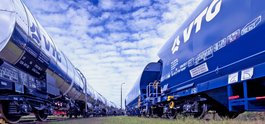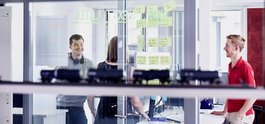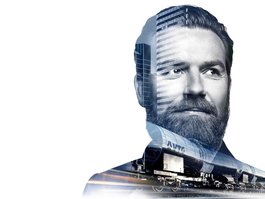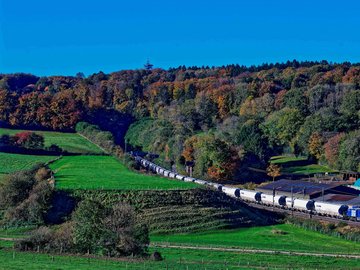
Environment
We are committed to making rail freight, combined and modular transport even kinder to the environment.
Rail is the sustainable mode of transport at the very core of our business model. It is also a powerful driver of efforts to ease the burdens placed on the climate and the environment by the transport sector. Our climate strategy envisages using renewable energy to move us toward climate neutrality while also reducing noise emissions. We have therefore established a Group-wide energy management system and adopted a systematic approach to waste management. While naturally upholding our obligation to comply with all current legislation and regulations to protect the environment, we also attach special importance to technical provisions surrounding the construction and operation of equipment and plant, as well as regulations governing the transportation of hazardous goods.
Another VTG commitment is to the sparing use of resources:
- VTG conserves resources in the building, operation and maintenance of its wagon and tank container fleets.
- Waste is avoided wherever possible, and unavoidable waste is recycled or properly disposed of.
- All staff willingly shoulder the obligation to conserve resources.
On top of these activities, VTG is actively involved in a variety of wider initiatives to protect the environment and mitigate climate change. Examples include Stiftung KlimaWirtschaft (the German CEO Alliance for Climate and Economy), UmweltPartnerschaft Hamburg (the Hamburg Partnership for the Environment), the Responsible Care Initiative and the Climate Bonds Initiative.
Climate change mitigation
Through a combination of responsible action, innovative solutions and the careful conservation of resources, VTG strives to combat climate change and sustainably contribute to improving quality of life. To reach our goal of climate neutrality by 2040, we plan to cut our Scope 1 and Scope 2 CO2 emissions in half by 2030. In 2021, we also migrated both our headquarters in Hamburg and one of our major sites in Duisburg to renewable energy. Further company locations will gradually follow suit, including our workshops Waggonwerk Brühl, Waggonbau Graaff and SEMA.
We support the implementation of the United Nations’ Sustainable Development Goals (SDGs) and give our full backing to the Paris Agreement and the European Green Deal.
VTG is also a member of Stiftung KlimaWirtschaft (the German CEO Alliance for Climate and Economy). The overriding goal of this alliance is to drive a significant reduction in global warming. Its members contribute their entrepreneurial solution skills, helping political actors to establish market conditions around climate change mitigation.
Energy Management
Efficient power consumption is one of the most important factors in mitigating climate change. Aware of this, we deploy a wide-ranging energy management system to ensure that energy performance is continually reviewed and improved at all our facilities.
We have already applied a raft of energy-saving measures. For example, merely replacing HQL lighting with LED lamps at our Ateliers de Joigny, Waggonwerk Brühl and Waggonbau Graaff workshops saves us almost 258 megawatt-hours of electricity – the equivalent of 66 tons of CO2. Similarly, modernizing the data center in Hamburg realized further energy efficiency gains.
Even small steps have an impact: Putting an energy-saving printer on each floor instead of having one on every desktop saved around six megawatt-hours of electricity, for example. At the same time, the routine behavior of our staff is a valuable complement to technical improvements. For instance, the engine drivers at VTG’s in-house railway company use simulations and test runs to learn energy-saving and climate-friendly ways of driving.
Noise reduction
Acoustic signals that reach the human ear are initially perceived as sound. But not until these sounds become exceptionally loud and protracted are they perceived as unpleasant. That is when we speak of noise. Yet noise is not a measurable parameter: It can only be assessed indirectly via the intensity and volume of a sound. The pressure and frequency of sound are measured to determine its volume, which is then converted onto a scale of decibels.
The human ear perceives a ten-decibel increase in volume as a doubling of the sound or noise – irrespective of how many decibels the sound began with. The opposite is equally true: For the human ear, reducing the volume by ten decibels has the effect of halving the perceived noise.
Part of countries’ national transport budgets is devoted to noise abatement measures. Proven ways to reduce noise along railway lines include:
- Erecting noise barriers
- Polishing the rails
- Deploying rail dampers
- Deploying rail greasing equipment
- Deadening sound on bridges
The brake blocks on wagons have traditionally been made of gray iron, a coarse mix of iron and graphite. In contrast, what are known as whisper brakes comprise new blends of materials such as mineral fibers, rubber and resins. These composite brake blocks prevent the wheels from being roughened but without impairing the braking action. Moreover, switching to whisper brakes can reduce noise by up to ten decibels – cutting in half the noise perceived by the human ear. However, if this effect is to be achieved, at least 90 percent of all a train’s wagons have to be refitted.
There are two options for fitting wagons with whisper brakes. While composite K blocks are mostly built into new wagons, wagons already in service can be retrofitted with the low-noise-low-friction (LL) blocks that have been approved across Europe since 2013. However, both variants significantly increase wear and tear, which drives up operating costs.
Step by step, VTG is converting its entire wagon fleet to low-noise brake blocks. This is often done in the context of regular revisions, although refits can also be performed by the Mobile Service team or when a wagon is in the workshop for other reasons. Refitting nevertheless involves a huge amount of work and a substantial financial burden, in part simply because of the cost of conversion, but also because LL brake blocks lead to considerably higher operating costs.
Until the end of 2022, refitting will continue to be subsidized by the European Commission’s Innovation and Networks Executive Agency (INEA) program.
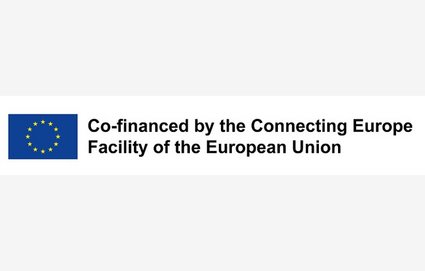
Waste management
We protect the environment by using resources effectively and by systematically managing waste in line with the principle of the circular economy. Essentially, this means avoiding waste wherever possible and recovering unavoidable waste in the best way possible. Durable, long-life products and the reuse of resources are two keys to this approach. VTG wagons are manufactured almost entirely from recyclable materials and have service lives of over 40 years. Wheelsets are refurbished several times before finally being recycled.
Where waste is unavoidable, we combine strict waste separation with proper recycling and disposal. One aspect is to separate hazardous from non-hazardous substances. Another is to separate paper from commercial waste at our office locations. Metal accounts for the majority of the waste at our workshops and is fed back into the circular economy via appropriate collection points. In this way, we consistently achieve a recycling rate of more than 90 percent in line with the European waste regulations. Looking ahead, however, we want to improve on even this very high level by reaching and sustaining a rate of 95 percent.
